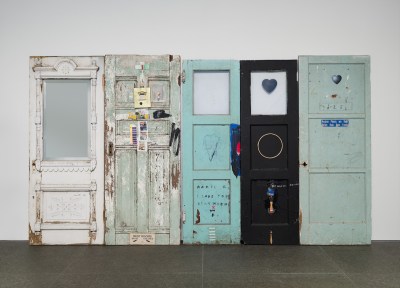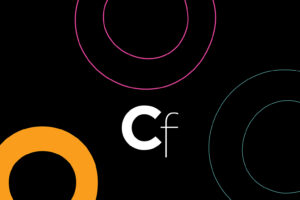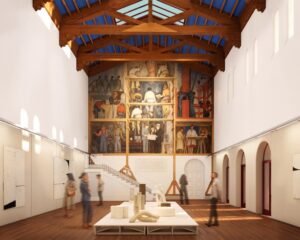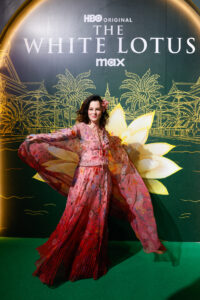Raymond Saunders Deserves to Be Canonized, and Now He Has the Retrospective to Prove It

The easiest—and laziest—way to describe Raymond Saunders’s bewitching paintings, now surveyed in a small but potent retrospective at the Carnegie Museum of Art in Pittsburgh, might be to call them “Rauschenbergian.” Just as Robert Rauschenberg once did, Saunders displays a penchant for messy scrawls and dirty canvases that he adorns with collected trinkets and pictures clipped from the media. Also à la Rauschenberg, Saunders produces artworks that feel like riddles, their surfaces rife with mysterious symbols and visual puns.
You can crack Rauschenberg’s codes if you work hard enough at it, but Saunders’s puzzles are a lot more elusive. The longer I stared at the 35 works in his Carnegie show, the less I seemed to understand them.
I must have spent a half-hour gazing at Passages: East, West 1 (1987), one of the many paintings here making extensive use of black for a background. Passages is monumentally scaled, just like many of its companions in the show, and features three chess boards, one drippy mustard-colored paint stroke, one appropriated reproduction of a Jan Brueghel still life (seemingly pinned to the canvas by a strip of tape but actually affixed to the surface by other means), one paintbrush (lightly used), several soap dishes (dirtied), what looks like wallpapering, and a whole lot more.
Divining all the connections between all these disparate objects is nearly impossible, but the key to the painting may be the Brueghel poster, which depicts a vase stuffed with flowers. Nearby, in chalk, Saunders has naturalistically sketched roses of his own rendering, placing his perennials beneath a magazine spread with a picture of a bouquet. Saunders seems to be playing representational games, asking: What’s the right way for an artist to portray a floral still life? Will any of those pictures ever measure up to the real thing?
But wait, there’s more. He’s crossed out the most finely rendered image here—the chalk one—as though he’d failed at his own exercise. Just when you think you know what Saunders is up to, you realize you haven’t gotten his art at all.
Clearly, Saunders is successful at being evasive. But it takes a special artist to make that slipperiness feel rewarding, and Saunders, thankfully, is that rare talent. He shows that good paintings shouldn’t give away their meaning so easily, since art is a fiction and fictions can only move us so close to the truth. He makes it feel nice to be led astray.
Saunders has never received a retrospective until now—a fact that feels astonishing, considering his importance. “Black Is a Color,” his 1967 essay refuting Ishmael Reed’s notion that Black art ought to evince a distinctly Black aesthetic, has been read widely, earning admirers such as art historian Darby English, who once wrote that Saunders’s text had “lost none of its pertinence.” Saunders showed with Terry Dintenfass, the New York dealer who also represented artists like Arthur Dove and Horace Pippin, and he appeared in Kellie Jones’s game-changing 2012 show “Now Dig This!: Art and Black Los Angeles 1960–1980.”

Raymond Saunders, Untitled, 1995.
Glenstone Museum/©2025 Estate of Raymond Saunders, All rights reserved/Photo Zachary Riggleman/Carnegie Museum of Art, Pittsburgh
But until a couple years ago, when Saunders joined David Zwirner’s roster, there was a sense that he had not quite achieved mainstream recognition, even though institutions have steadily acquired his art. Nearly all the works in the Carnegie exhibition are on loan from major museums in this country, from the National Gallery of Art to the Metropolitan Museum of Art. That’s a sign that Saunders’s work has plenty of appreciators—even if many of those institutions have rarely, if ever, exhibited these wonderful paintings. His Carnegie show is solid proof that he deserves canonization.
The exhibition, curated by Eric Crosby, is partly an attempt to reclaim Saunders as a hometown legend. Saunders was born in 1934 in Pittsburgh, where he grew up visiting the museum’s institution’s Carnegie International exhibitions as well as the nearby Carnegie Museum of Natural History. Later on, he would recall taking in paintings by Henri Matisse and Pablo Picasso, as well as exhibitions of dinosaur fossils and dioramas filled with fake birds. Seeing all these disparate sights in one museum complex seems to have instilled in him the omnivorous sensibility evident today in his art.
Joseph C. Fitzpatrick, an art teacher in the Pittsburgh school system who would later count Andy Warhol among his students, took Saunders under his wing and pushed him toward becoming an artist. Saunders began taking art courses at the Pennsylvania Academy of the Fine Arts and the Carnegie Institute of Technology, then moved to Oakland, California, in 1960.
There, he began producing works defined by their smudgy, inky strokes, including Night Vision (1962), in which a cloud of blackness stands in for what appears to be a marsh, with several barely-there reeds peeking through the surface. The painting is one of the earliest in the Carnegie show, and it suggests that Saunders was already trying to confuse his viewers’ eyes. It is impossible, after all, to see in the dark.

Installation view of “Raymond Saunders: Flowers from a Black Garden,” 2025, at Carnegie Museum of Art, Pittsburgh.
©2025 Estate of Raymond Saunders, All rights reserved/Photo Zachary Riggleman/Carnegie Museum of Art, Pittsburgh
Black also prevails in a painting produced just a year later, Something about Something (1963), which aligns Saunders with the prevailing avant-garde modes of his day. It features a nonsense string of numbers and letters that appear stenciled but are in fact painted—a gesture clearly cribbed from Jasper Johns, another artist with a wonderful sense for optical illusions and aesthetic encryption.
Something feels a bit too much like Johns-lite, but Saunders came into his own by the end of the ’60s with works such as Post No Bills (1968), in which a blazing red monochrome plays host to a painter’s palette affixed to the canvas. Streaked with blue, the palette interrupts the purity of this long crimson rectangle, which also contains two strips of red tape at its top—a makeshift cross, perhaps, or more likely a crosshair.
Not so long before Saunders made Post No Bills, painters treated their craft as something sacred—the Abstract Expressionist painter Barnett Newman once called his chosen medium a “religious art.” Saunders took a much more sacrilegious tack, and did so, in part, by making crucifixes out of unevenly sliced tape in his paintings of the 1970s and ’80s. One such work, from 1975, is even called I Don’t Go to Church Anymore.

Installation view of “Raymond Saunders: Flowers from a Black Garden,” 2025, at Carnegie Museum of Art, Pittsburgh.
©2025 Estate of Raymond Saunders, All rights reserved/Photo Zachary Riggleman/Carnegie Museum of Art, Pittsburgh
And just as Saunders does not worship at the altar of Christianity, he does not seem deferential to art history, either. Jacob Lawrence, Romare Bearden, American (1988) is named for two great Black modernists, both of whose names are written by Saunders onto his surface. Like an insolent child at a blackboard, Saunders has scribbled over their names, instead paying more mind to torn-up posters, kids’ drawings, and a Dots candy box that he has also included. A piece of ephemera from Tail of the Yak, a legendary (and now defunct) Oakland boutique known for its idiosyncratic offerings, is more visible here than any allusions to Bearden or Lawrence.
With works such as that one, Saunders seems to have intentionally crafted art that was illegible. But might not the Carnegie show have made his work more inscrutable than necessary? Quotes by Saunders constitute the bulk of the wall texts here; no catalog was produced for the show. The dearth of explanatory material makes these puzzling artworks even tougher to comprehend.

Installation view of “Raymond Saunders: Flowers from a Black Garden,” 2025, at Carnegie Museum of Art, Pittsburgh.
©2025 Estate of Raymond Saunders, All rights reserved/Photo Zachary Riggleman/Carnegie Museum of Art, Pittsburgh
It’s true that Saunders’ art speaks well enough for itself, particularly his works from the ’90s, which have a more explicitly political character. Not Always Invited to Dinner (1995), for example, addresses racism and acceptance, placing appropriated images, including a photograph of Malcolm X, beside an advertisement for hand soap—a piercing juxtaposition that suggests that Black Americans will always be a part of the picture until someone decides to scrub them out of it. You don’t need to know a lot about Saunders to gain that much from this painting.
But it is sometimes less obvious what Saunders is up to, which is partly because he’s always been clear about one thing: he isn’t trying to make art that’s easy. “i’m not here to play to the gallery,” Saunders wrote in 1967, in his all-lowercase essay “Black Is a Color,” and if you didn’t get it, stop by the show’s greatest treasure, The Gift of Presence (1993–94). Composed of several dirtied doors adorned with all sorts of objects, The Gift of Presence acts like a manifesto for Saunders. The handwritten Lawrence and Bearden references return, as do the ready-made religious images and allusions to Johns (here in the form of a sloppily painted American flag). Beneath, a scrawled list of names paying homage to jazz legends, Saunders has included a wooden sign that reads “I IS RETIRED.” “WHEN I FEEL THE URGE TO WORK—I LAY DOWN TO THE URGE PASSES,” the sign reads. Saunders won’t perform the labor of explaining this work to you, and he shouldn’t have to, either.







